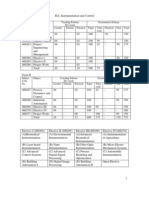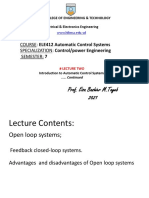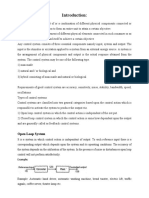0 ratings0% found this document useful (0 votes)
Chapter 1 Introduction
Chapter 1 Introduction
Uploaded by
Tiến PhátCopyright:
© All Rights Reserved
Available Formats
Download as PPTX, PDF, TXT or read online from Scribd
Download as pptx, pdf, or txt
Chapter 1 Introduction
Chapter 1 Introduction
Uploaded by
Tiến Phát0 ratings0% found this document useful (0 votes)
Copyright
© © All Rights Reserved
Available Formats
PPTX, PDF, TXT or read online from Scribd
Share this document
Did you find this document useful?
Is this content inappropriate?
Copyright:
© All Rights Reserved
Available Formats
Download as PPTX, PDF, TXT or read online from Scribd
Download as pptx, pdf, or txt
0 ratings0% found this document useful (0 votes)
Chapter 1 Introduction
Chapter 1 Introduction
Uploaded by
Tiến PhátCopyright:
© All Rights Reserved
Available Formats
Download as PPTX, PDF, TXT or read online from Scribd
Download as pptx, pdf, or txt
You are on page 1/ 24
Advance Control
Theory
Lecturer: VU VAN PHONG
Dr. Van-Phong Vu-Department of Automatic Control
Instructor: Dr. Vu Van Phong
Email: phongvv@hcmute.edu.vn
Phone: 0981479507
Websites: https://phongvuac.wixsite.com/vuphong/
Dr. Van-Phong Vu-Department of Automatic Control
Rules in Class
Attend at least 80% of class hours
Complete all homeworks and assignments (If any)
Dr. Van-Phong Vu-Department of Automatic Control
Assessment
Assignment (50%)
One assignment/homework. (20%)
One midterm test (20%)
Attendance (10%)
Final Project (50%)
Student have to complete a small project and present in the class.
Dr. Van-Phong Vu-Department of Automatic Control
Textbook and References
[1] Linear Robust control, Michael Green, David J.N. Limebeer, Pearson
Education
[2] Nonlinear system: Analysis, Stability, and Control, Sharnkar Sátry,
Springer, 1999.
[3] D. L. Smith, Introduction to Dynamic Systems Modeling for Design,
Prentice-Hall, 1994.
[4] L. Ljung, System Identification – Theory for the users, 2 nd Edition,
Prentice-Hall, 1999.
[5] R. Johansson, System Modeling and Identification, Prentice-Hall, 1993.
[6] L. Ljung, System Identification Toolbox TM Getting Started Guide in
Matlab, The MathWorks, Inc, 2016
Dr. Van-Phong Vu-Department of Automatic Control
Contents of This course
Chapter 1: Introduction
Chapter 2: Nonlinear control system
2.1 Nonlinear system
2.2 Lyapunov Theory
2.3 Sliding mode control
Chapter 3: Optimal Control
3.1 LQR Controller
3.2 Kalman filter
3.3 LQG controller
Chapter 4: Robust Control
4.1 H-infinite controller
Dr. Van-Phong Vu-Department of Automatic Control
Chapter 1: Introduction
Dr. Van-Phong Vu-Department of Automatic Control
Contents of Chapter 1
1.1 Purpose of this course
1.2 Introduction of nonlinear control system
1.3 Introduction of Optimal Control
1.4 Introduction of Robust control
1.5 Introduction of Adaptive control
Dr. Van-Phong Vu-Department of Automatic Control
1.1 Purpose of this course
Purpose:
Understand the nonlinear system
Understand and apply the Lyapunov theory for design both
controller and observer.
Design the sliding mode controller
Design the robust controller
Design the Optimal Controller (LQR, LQG)
Dr. Van-Phong Vu-Department of Automatic Control
1.2 Nonlinear System
Almost the system in practice is expressed under the nonlinear
form.
The nonlinear control system was introduced from 19 century.
After 1960, Nonlinear control system is significantly developed
Dr. Van-Phong Vu-Department of Automatic Control
1.2 Nonlinear System
Method to analyze the nonlinear systems:
Phương pháp mặt phẳng pha
Phương pháp mô tả
Phương pháp ổn định Lyapunov
Phương pháp ổn định Popov
Phương pháp độ lợi bé
Phương pháp thụ động
Dr. Van-Phong Vu-Department of Automatic Control
1.2 Nonlinear System
Methods to design controller:
Sliding mode controller ( điều khiển trượt)
Backstepping control ( điều khiển cuốn chiếu)
Dr. Van-Phong Vu-Department of Automatic Control
1.3 Optimal control
Dr. Van-Phong Vu-Department of Automatic Control
1.4 Adaptive control
Dr. Van-Phong Vu-Department of Automatic Control
1.4 Adaptive control
Dr. Van-Phong Vu-Department of Automatic Control
1.5 Robust control
Dr. Van-Phong Vu-Department of Automatic Control
1.5 Robust control
Dr. Van-Phong Vu-Department of Automatic Control
Example
Dr. Van-Phong Vu-Department of Automatic Control
Example
Dr. Van-Phong Vu-Department of Automatic Control
Example
Dr. Van-Phong Vu-Department of Automatic Control
Application in practice
Dr. Van-Phong Vu-Department of Automatic Control
Example
Dr. Van-Phong Vu-Department of Automatic Control
Example
Dr. Van-Phong Vu-Department of Automatic Control
Thank You For Your Listening
Dr. Van-Phong Vu-Department of Automatic Control
You might also like
- Feedback Control System: Introduction To Control SystemNo ratings yetFeedback Control System: Introduction To Control System45 pages
- MAAE 4500 Feedback Control Systems: Prof. Jie Liu (Sections A) Mechanical and Aerospace EngineeringNo ratings yetMAAE 4500 Feedback Control Systems: Prof. Jie Liu (Sections A) Mechanical and Aerospace Engineering29 pages
- BE Instrumentation Syllabus 2011 Pune UniversityNo ratings yetBE Instrumentation Syllabus 2011 Pune University34 pages
- Be Instrumentation Control Syllabus CourseNo ratings yetBe Instrumentation Control Syllabus Course43 pages
- Download full (Ebook) Design Of Nonlinear Control Systems With The Highest Derivative In Feedback (Series on Stability, Vibration and Control of Systems, Series a) by Valery D. Yurkevich ISBN 9789812388995, 9812388990 ebook all chapters100% (1)Download full (Ebook) Design Of Nonlinear Control Systems With The Highest Derivative In Feedback (Series on Stability, Vibration and Control of Systems, Series a) by Valery D. Yurkevich ISBN 9789812388995, 9812388990 ebook all chapters81 pages
- Buy ebook Design of Nonlinear Control Systems with the Highest Derivative in Feedback Valery D. Yurkevich cheap price100% (3)Buy ebook Design of Nonlinear Control Systems with the Highest Derivative in Feedback Valery D. Yurkevich cheap price72 pages
- Design of Nonlinear Control Systems With The Highest Derivative in FeedbackNo ratings yetDesign of Nonlinear Control Systems With The Highest Derivative in Feedback374 pages
- Instant Download Instrumentation and Control Systems 3rd Edition - eBook PDF PDF All Chapters100% (16)Instant Download Instrumentation and Control Systems 3rd Edition - eBook PDF PDF All Chapters56 pages
- Download Advances and Applications in Nonlinear Control Systems 1st Edition Sundarapandian Vaidyanathan ebook All Chapters PDF100% (1)Download Advances and Applications in Nonlinear Control Systems 1st Edition Sundarapandian Vaidyanathan ebook All Chapters PDF55 pages
- Session 1 Introduction To Control Systems: Learning OutcomesNo ratings yetSession 1 Introduction To Control Systems: Learning Outcomes8 pages
- Introduction To Control Systems-Student-2021 - 2022 New100% (1)Introduction To Control Systems-Student-2021 - 2022 New885 pages
- Pe-3032 WK 1 Introduction To Control System March 04100% (2)Pe-3032 WK 1 Introduction To Control System March 0470 pages
- Introduction To Control Systems: Unit - 1No ratings yetIntroduction To Control Systems: Unit - 119 pages
- Introduction To Instrumentation and Control SystemNo ratings yetIntroduction To Instrumentation and Control System25 pages
- Discontinuous Control Systems 1st Edition Igor Boiko (Auth.) 2024 scribd download100% (5)Discontinuous Control Systems 1st Edition Igor Boiko (Auth.) 2024 scribd download77 pages
- FALLSEM2023-24 BECE302L TH VL2023240100269 2023-04-24 Reference-Material-INo ratings yetFALLSEM2023-24 BECE302L TH VL2023240100269 2023-04-24 Reference-Material-I5 pages
- Ee3512 Control and Instrumentation Laboratory100% (1)Ee3512 Control and Instrumentation Laboratory2 pages
- Model Predictive Control For DC Motors: Lafta E. J. Alkurawy Nisreen KhamasNo ratings yetModel Predictive Control For DC Motors: Lafta E. J. Alkurawy Nisreen Khamas6 pages
- Direct Torque Control of Three Phase Induction Motor Drive Using Fuzzy Logic Controllers For Low Torque RippleNo ratings yetDirect Torque Control of Three Phase Induction Motor Drive Using Fuzzy Logic Controllers For Low Torque Ripple6 pages
- Jawaharlal Nehru Technological University Anantapur B.Tech (ECE) - III-I Sem L T P C 3 0 0 3 (20A04502T) Digital Signal Processing Course ObjectivesNo ratings yetJawaharlal Nehru Technological University Anantapur B.Tech (ECE) - III-I Sem L T P C 3 0 0 3 (20A04502T) Digital Signal Processing Course Objectives1 page
- Antenna Azimuth Position Control With Classical PID and Fuzzy Logic ControllersNo ratings yetAntenna Azimuth Position Control With Classical PID and Fuzzy Logic Controllers5 pages
- Robust Attitude Stabilization of A Quadrotor by Using LFT Linear-Parameter-Varying HNo ratings yetRobust Attitude Stabilization of A Quadrotor by Using LFT Linear-Parameter-Varying H6 pages
- Selection of IRCON Temperature ControllersNo ratings yetSelection of IRCON Temperature Controllers4 pages
- Stability Analysis For A Class of Takagi-Sugeno Fuzzy Control SystemsNo ratings yetStability Analysis For A Class of Takagi-Sugeno Fuzzy Control Systems12 pages
- Fall 2023 Course 6.30 - 6.70 - Electrical Engineering and Computer ScienceNo ratings yetFall 2023 Course 6.30 - 6.70 - Electrical Engineering and Computer Science13 pages
- Good-Comparison of Friction Models Applied To A Control ValveNo ratings yetGood-Comparison of Friction Models Applied To A Control Valve13 pages
- Release Notes For Model Predictive Control Toolbox™No ratings yetRelease Notes For Model Predictive Control Toolbox™55 pages
- 小论文 - Benefits of Over-Actuation in Motion SystemsNo ratings yet小论文 - Benefits of Over-Actuation in Motion Systems6 pages
- Taller #1 - Arduino Ejercicios: Codigo - Cancion Unravel Toky GoulNo ratings yetTaller #1 - Arduino Ejercicios: Codigo - Cancion Unravel Toky Goul33 pages
- Bachelor of Technology (Electrical Engineering) Third Semester Examination Code No. Paper L T/P Credit Theory PapersNo ratings yetBachelor of Technology (Electrical Engineering) Third Semester Examination Code No. Paper L T/P Credit Theory Papers15 pages
- 2.3 Stability of Feedback Control SystemsNo ratings yet2.3 Stability of Feedback Control Systems30 pages
- PID Control With Fuzzy Compensation For Hydroelectric Generating Unit - For ThanhNo ratings yetPID Control With Fuzzy Compensation For Hydroelectric Generating Unit - For Thanh5 pages
- Data Sheet For SINAMICS G120C: Rated Data General Tech. SpecificationsNo ratings yetData Sheet For SINAMICS G120C: Rated Data General Tech. Specifications2 pages
- Adaptive Output-Feedback Image-Based Visual Servoing For Quadrotor Unmanned Aerial VehiclesNo ratings yetAdaptive Output-Feedback Image-Based Visual Servoing For Quadrotor Unmanned Aerial Vehicles8 pages
- Feedback Control System: Introduction To Control SystemFeedback Control System: Introduction To Control System
- MAAE 4500 Feedback Control Systems: Prof. Jie Liu (Sections A) Mechanical and Aerospace EngineeringMAAE 4500 Feedback Control Systems: Prof. Jie Liu (Sections A) Mechanical and Aerospace Engineering
- Download full (Ebook) Design Of Nonlinear Control Systems With The Highest Derivative In Feedback (Series on Stability, Vibration and Control of Systems, Series a) by Valery D. Yurkevich ISBN 9789812388995, 9812388990 ebook all chaptersDownload full (Ebook) Design Of Nonlinear Control Systems With The Highest Derivative In Feedback (Series on Stability, Vibration and Control of Systems, Series a) by Valery D. Yurkevich ISBN 9789812388995, 9812388990 ebook all chapters
- Buy ebook Design of Nonlinear Control Systems with the Highest Derivative in Feedback Valery D. Yurkevich cheap priceBuy ebook Design of Nonlinear Control Systems with the Highest Derivative in Feedback Valery D. Yurkevich cheap price
- Design of Nonlinear Control Systems With The Highest Derivative in FeedbackDesign of Nonlinear Control Systems With The Highest Derivative in Feedback
- Instant Download Instrumentation and Control Systems 3rd Edition - eBook PDF PDF All ChaptersInstant Download Instrumentation and Control Systems 3rd Edition - eBook PDF PDF All Chapters
- Download Advances and Applications in Nonlinear Control Systems 1st Edition Sundarapandian Vaidyanathan ebook All Chapters PDFDownload Advances and Applications in Nonlinear Control Systems 1st Edition Sundarapandian Vaidyanathan ebook All Chapters PDF
- Session 1 Introduction To Control Systems: Learning OutcomesSession 1 Introduction To Control Systems: Learning Outcomes
- Introduction To Control Systems-Student-2021 - 2022 NewIntroduction To Control Systems-Student-2021 - 2022 New
- Pe-3032 WK 1 Introduction To Control System March 04Pe-3032 WK 1 Introduction To Control System March 04
- Introduction To Instrumentation and Control SystemIntroduction To Instrumentation and Control System
- Discontinuous Control Systems 1st Edition Igor Boiko (Auth.) 2024 scribd downloadDiscontinuous Control Systems 1st Edition Igor Boiko (Auth.) 2024 scribd download
- FALLSEM2023-24 BECE302L TH VL2023240100269 2023-04-24 Reference-Material-IFALLSEM2023-24 BECE302L TH VL2023240100269 2023-04-24 Reference-Material-I
- Model Predictive Control For DC Motors: Lafta E. J. Alkurawy Nisreen KhamasModel Predictive Control For DC Motors: Lafta E. J. Alkurawy Nisreen Khamas
- Direct Torque Control of Three Phase Induction Motor Drive Using Fuzzy Logic Controllers For Low Torque RippleDirect Torque Control of Three Phase Induction Motor Drive Using Fuzzy Logic Controllers For Low Torque Ripple
- Jawaharlal Nehru Technological University Anantapur B.Tech (ECE) - III-I Sem L T P C 3 0 0 3 (20A04502T) Digital Signal Processing Course ObjectivesJawaharlal Nehru Technological University Anantapur B.Tech (ECE) - III-I Sem L T P C 3 0 0 3 (20A04502T) Digital Signal Processing Course Objectives
- Antenna Azimuth Position Control With Classical PID and Fuzzy Logic ControllersAntenna Azimuth Position Control With Classical PID and Fuzzy Logic Controllers
- Robust Attitude Stabilization of A Quadrotor by Using LFT Linear-Parameter-Varying HRobust Attitude Stabilization of A Quadrotor by Using LFT Linear-Parameter-Varying H
- Stability Analysis For A Class of Takagi-Sugeno Fuzzy Control SystemsStability Analysis For A Class of Takagi-Sugeno Fuzzy Control Systems
- Fall 2023 Course 6.30 - 6.70 - Electrical Engineering and Computer ScienceFall 2023 Course 6.30 - 6.70 - Electrical Engineering and Computer Science
- Good-Comparison of Friction Models Applied To A Control ValveGood-Comparison of Friction Models Applied To A Control Valve
- Release Notes For Model Predictive Control Toolbox™Release Notes For Model Predictive Control Toolbox™
- 小论文 - Benefits of Over-Actuation in Motion Systems小论文 - Benefits of Over-Actuation in Motion Systems
- Taller #1 - Arduino Ejercicios: Codigo - Cancion Unravel Toky GoulTaller #1 - Arduino Ejercicios: Codigo - Cancion Unravel Toky Goul
- Bachelor of Technology (Electrical Engineering) Third Semester Examination Code No. Paper L T/P Credit Theory PapersBachelor of Technology (Electrical Engineering) Third Semester Examination Code No. Paper L T/P Credit Theory Papers
- PID Control With Fuzzy Compensation For Hydroelectric Generating Unit - For ThanhPID Control With Fuzzy Compensation For Hydroelectric Generating Unit - For Thanh
- Data Sheet For SINAMICS G120C: Rated Data General Tech. SpecificationsData Sheet For SINAMICS G120C: Rated Data General Tech. Specifications
- Adaptive Output-Feedback Image-Based Visual Servoing For Quadrotor Unmanned Aerial VehiclesAdaptive Output-Feedback Image-Based Visual Servoing For Quadrotor Unmanned Aerial Vehicles
























































































